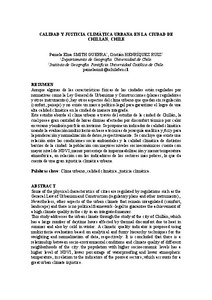Por favor, use este identificador para citar o enlazar este ítem:
http://hdl.handle.net/20.500.11765/9948
Calidad y justicia climática urbana en la ciudad de Chillán, Chile
| Título : | Calidad y justicia climática urbana en la ciudad de Chillán, Chile |
| Autor : | Smith, Pamela; Henríquez, Cristián |
| Palabras clave : | Clima urbano; Calidad climática; Justicia climática; Urban climate; Climate quality; Climate justice |
| Fecha de publicación : | 2018 |
| Editor: | Asociación Española de Climatología; Agencia Estatal de Meteorología |
| Citación : | Montávez Gómez, Juan Pedro, et al. (eds.). El clima: aire, agua, tierra y fuego. Madrid: Asociación Española de Climatología; Agencia Estatal de Meteorología, 2018, p. 711-720 |
| Serie/Num. : | Publicaciones de la Asociación Española de Climatología. Serie A;11 |
| Resumen : | [ES]Aunque algunas de las características físicas de las ciudades están regulados por normativas como la Ley General de Urbanismo y Construcciones (planes reguladores y otros instrumentos), hay otros aspectos del clima urbano que quedan sin regulación (confort, paisaje) y no existe un marco político-legal para garantizar el logro de una alta calidad climática en la ciudad de manera integrada. Este estudio aborda el clima urbano a través del estudio de la ciudad de Chillán, la cual posee gran cantidad de horas diurnas afectadas por disconfort térmico por calor en verano y también por frío en invierno. Se propone un indicador de calidad climática usando la evaluación multicriterio en base a técnicas de jerarquía analítica y fuzzy para la ponderación y normalización de datos, respectivamente. Se concluye que existe una relación entre las condiciones socio ambientales y la calidad climática de distintos barrios de la ciudad: la población con mayores niveles socioeconómicos cuenta con mayor nivel de NDVI, menor porcentaje de impermeabilización y menor temperatura atmosférica, en relación con los indicadores de los sectores más pobres, lo que da cuenta de una gran injusticia climática urbana. [EN]Some of the physical characteristics of cities are regulated by regulations such as the General Law of Urbanism and Construction (regulatory plans and other instruments). Nevertheless, other aspects of the urban climate that remain unregulated (comfort, landscape) and there is no political framework -legal to guarantee the achievement of a high climate quality in the city in an integrated manner. This study addresses the urban climate through the study of the city of Chillán, which has a large number of daytime hours affected by thermal discomfort due to heat in summer and also by cold in winter. A climatic quality indicator is proposed using multicriteria evaluation based on analytical and fuzzy hierarchy techniques for the weighting and normalization of data, respectively. It is concluded that there is a relationship between socio-environmental conditions and climate quality of different neighborhoods of the city: the population with higher socioeconomic levels has a higher level of NDVI, lower percentage of waterproofing and lower atmospheric temperature, in relation to the indicators of the poorest sectors, which accounts for a great urban climate injustice. |
| Descripción : | Ponencia presentada en: XI Congreso de la Asociación Española de Climatología celebrado en Cartagena entre el 17 y el 19 de octubre de 2018. |
| URI : | http://hdl.handle.net/20.500.11765/9948 |
| ISBN : | 978-84-7837-098-6 |
| Colecciones: | (2018, Cartagena). XI Congreso AEC |
Ficheros en este ítem:
| Fichero | Descripción | Tamaño | Formato | ||
|---|---|---|---|---|---|
| 0064_XI_2018_SMITH.pdf | 142,46 MB | Adobe PDF |  Visualizar/Abrir |
Los ítems de Arcimis están protegidos por una Licencia Creative Commons, salvo que se indique lo contrario.





